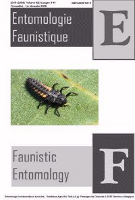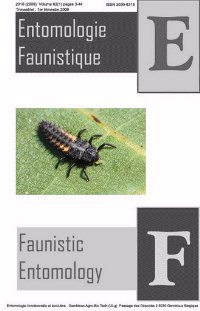- Portada
- Volume 70 (2017)
- Thrips in citrus orchards, emerging pests in Tunisia
Vista(s): 1459 (13 ULiège)
Descargar(s): 1330 (10 ULiège)
Thrips in citrus orchards, emerging pests in Tunisia

Résumé
Dans plusieurs pays méditerranéens, les thrips sont des ravageurs des agrumes causant de graves cicatrices sur la surface du fruit. En Tunisie, le statut de ces insectes reste inconnu. Cette étude a porté sur l'inventaire des thrips sur agrumes, leur abondance, leur importance économique liée aux agrumes et leurs fluctuations saisonnières par rapport à la phénologie des plantes hôtes. L'étude a été réalisée dans 6 vergers d'orangers à Bizerte, Cap-Bon et Mornag, situés dans le Nord et dans des zones importantes de production d'agrumes. Les thrips ont été récoltés par 3 méthodes : échantillonnage des fleurs, du sol et par l’utilisation de pièges collants. L'estimation des dégâts de thrips a été réalisée sur les fruits mûrs/jeunes fruits. Treize genres et 14 espèces ont été observés, dont les plus abondantes étaient Thrips major (Uzel 1895), Pezothrips kellyanus (Bagnall 1916) et Frankliniella occidentalis (Pergande 1885) avec respectivement 90,0 %, 3,3 % et 2,6 % des thrips collectés. Les principaux dégâts observés étaient soit sous forme de marbrures argentés couvrant une surface plus ou moins étendue variant de 11 à 70 % des fruits soit des dégâts minimes sous forme d’anneau à la base des pédoncules, spécifique à P. kellyanus. Les vergers les plus infestées étaient à Bizerte avec 4 adultes/fleur, tandis qu’à Cap-Bon qui est la principale zone de production d’agrumes, le niveau était 10 fois plus faible. Les densités les plus élevées de larves et d’adultes de T. major ont été enregistrées au printemps, à la floraison et la chute des pétales, avec une tendance à se concentrer principalement sur le côté nord de la canopée. Ce travail contribue à améliorer les connaissances du statut des thrips sur agrumes en Tunisie. Ces ravageurs nécessitent de nouvelles recherches pour comprendre les facteurs favorisant leur multiplication et leur contrôle notamment au Cap-Bon.
Abstract
In several Mediterranean countries, thrips have emerged as pests of citrus that cause severe scarring of fruit surface. In Tunisia, the accurate status of these insects remains unknown. This research focused on the inventory of species living on citrus, their abundance, economic significance related to citrus and their seasonal fluctuations in relation to host plant phenology. The study was carried out in 6 orange orchards in Bizerte, Cap-Bon and Mornag, all located in the North and important citrus production areas. Thrips were collected using 3 methods: flower and soil samples and sticky traps. The estimate of thrips damage was achieved on mature and young fruits. Thirteen genus and 14 species were observed, the most abundant were Thrips major (Uzel 1895), Pezothrips kellyanus (Bagnall 1916) with and Frankliniella occidentalis (Pergande 1885) with with 90.0 %, 3.3 % and 2.6 % of the fauna's thrips respectively. The main damage observed were silvery marblings covering a surface more or less extended and varying from 11 to 70 % of fruits and at a lesser degree rings at the base of the peduncles, specific of P. kellyanus. The most infested orchards were in Bizerte with 4 adults/flower, while in Cap-Bon which is the main citrus production area; the level was 10 times lower. The monitoring of larvae and adults of T. major in soil, air and citrus organs showed that the highest densities were recorded in spring, at flowering and petal fall, with tendency to concentrate mostly on the northern side of canopy. At the end of spring and with the development of young fruit, the percentage of infested organs decreased. This work contributed to improve knowledge on thrips status in Tunisia. It pointed out that in Cap-Bon region as well as in Mornag, thrips populations were present in low levels while in Bizerte they were more abundant and mainly represented by T. major the most common species. These emerging pests need a regular survey to understand factors that increase their densities and further control to prevent outbreaks in Cap-Bon.






